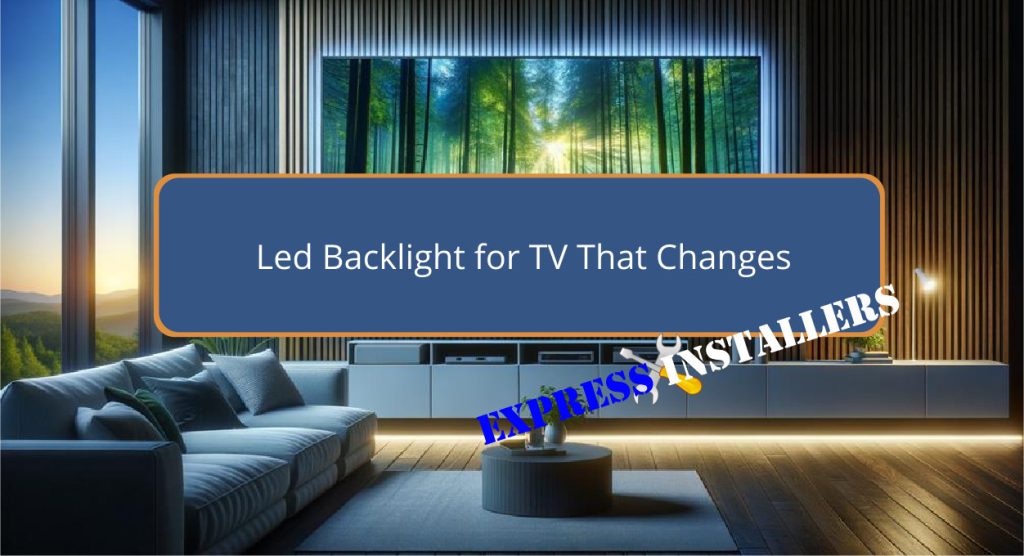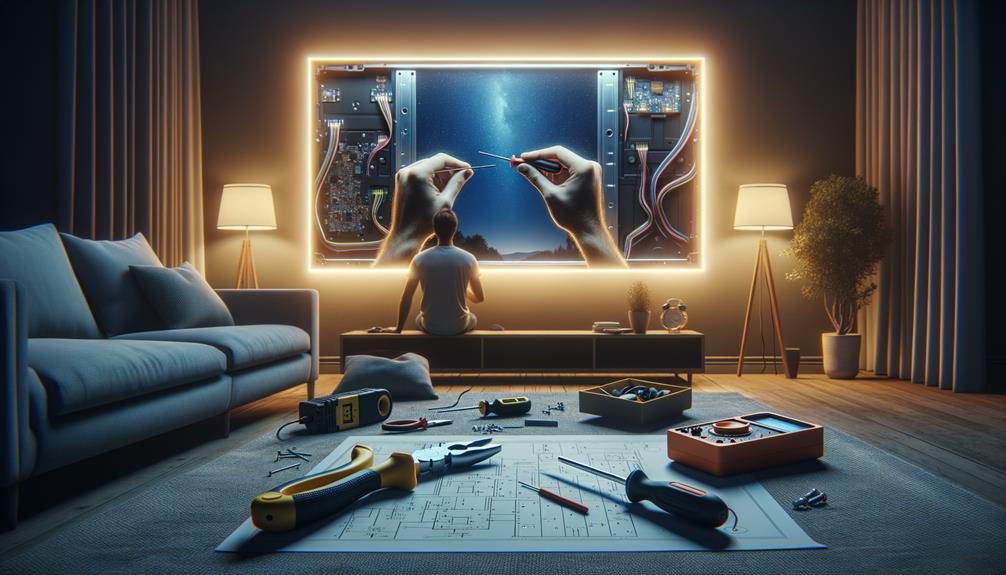
LED backlights for TVs that adapt to the changing picture leverage advanced technologies to dynamically synchronise colours and enhance viewer immersion.
This system uses real-time scene analysis to align the backlight colors with on-screen content, seamlessly extending the visual experience beyond the screen.
It not only reduces eye strain by providing a more uniform lighting experience but also enhances the overall mood through customisable atmospheric conditions.
Incorporating such technology involves measuring the TV for proper LED strip length, ensuring a clean attachment surface, and syncing with the TV’s picture dynamics.
More details are available on how this technology can transform your viewing setup.
Quick Summary
- Dynamic LED backlights adapt colors and brightness in sync with the TV picture for an immersive viewing experience.
- Installation involves measuring the TV and attaching the LED strips securely to the back.
- Synchronised lighting extends the on-screen colours into the room, enhancing the atmosphere and reducing eye strain.
- The Govee Immersion TV backlight kit features RGBIC technology, allowing for vibrant and interactive lighting effects.
- Control and customisation are facilitated through apps like Govee Home, enabling real-time colour adjustments to match on-screen content.
Understanding Dynamic LED Technology
Dynamic LED backlight technology employs sophisticated algorithms to dynamically adjust the backlight colours in synchronisation with the content displayed, enhancing the visual immersion and interactivity of the viewing experience.
This technology leverages real-time analysis to achieve precise colour synchronisation, ensuring that the backlight colours accurately match the on-screen visuals.
As scenes shift from one to another, the LEDs adapt seamlessly, maintaining an immersive environment that complements the narrative or visual content.
This adaptive mechanism is critical in providing a cohesive viewing experience where the ambient lighting is not merely a static background but an active participant in the visual storytelling.
Through this advanced integration, dynamic LED technology transforms the standard viewing setup into a more engaging and personalised visual journey.
Benefits of Synchronised Lighting
Building on the advancements in dynamic LED technology, synchronised lighting greatly enhances the overall viewing experience by extending on-screen colors into the viewer’s environment.
This integration not only elevates the visual aesthetics but also incorporates significant health benefits and entertainment enhancement.
Below are key benefits:
- Reduction of Eye Strain: The ambient lighting minimises the contrast between the bright screen and dark surroundings, reducing eye fatigue.
- Immersive Experience: By mirroring on-screen events, viewers feel as though they are part of the action, increasing engagement.
- Mood Enhancement: Colors and brightness adjust to match the scene, enhancing the emotional impact of the content.
- Customisable Atmosphere: Users can tailor the lighting effects to their personal preference, optimising the viewing experience for different types of content.
Installation and Setup Guide

To guarantee proper installation of your TV’s LED backlight system, first measure the television to select the appropriate length of LED strips.
Confirm the back of the TV is clean before adhering the strips, as dust can prevent secure attachment, leading to potential installation mistakes.
Connect the strips to a power source and synchronise them with the TV’s picture settings for dynamic color changes.
This setup allows for DIY customisation with various colour options, enhancing your viewing experience.
For troubleshooting tips, verify all connections are tight and the control settings are accurately configured.
Proper setup ensures the backlight not only enhances ambiance but also functions seamlessly with changing visuals.
Top LED Backlight Models
Among the leading models, the Govee Immersion TV backlight kit stands out by synchronising its RGBIC technology with on-screen content to enhance viewing immersion.
This model is highly acclaimed in the comparison chart for its innovative features and user-friendly interface, as evidenced by positive customer reviews.
Key aspects of the Govee Immersion TV backlight kit include:
- RGBIC Technology: Allows for individual control of color segments, creating vibrant and dynamic backlights.
- Interactive Modes: Reacts to both music and video, adjusting the backlight to suit the ambiance.
- App Control: Utilise the Govee Home app to customise effects and settings seamlessly.
- Enhanced Viewing Experience: Provides a balanced visual experience that shifts with the content displayed, ensuring an immersive viewing environment.
Frequently Asked Questions
How Do You Sync LED Lights to TV?
To synchronise LED lights with a TV, guarantee meticulous colour accuracy by selecting compatible devices. Follow the defined installation process, integrating control systems or apps that detect and mirror the on-screen colour dynamics.
What Are the Different Types of LED TV Backlight?
Different types of LED TV backlights include edge lighting, which offers slim profiles and cost efficiency, and full array backlights, which provide superior brightness and contrast by distributing LEDs directly behind the screen.
Is It Worth Replacing the Backlight on a TV?
Replacing the backlight on a TV is often justified considering the benefits of enhanced visual quality against repair costs, particularly when factoring in the extended lifespan and efficiency of modern LED backlight technologies.
Do TV Backlights Make a Difference?
TV backlights greatly enhance viewing comfort by reducing eye strain and improving perceived image contrast. They contribute to energy efficiency by requiring less front-screen brightness, thereby extending overall device lifespan and user experience.
Conclusion
To sum up, thorough LED backlight technology greatly enhances the viewing experience by synchronising ambient lighting with on-screen content, thereby creating immersive visual environments.
The installation of these systems, while intricate, is aided by detailed guides provided with top models on the market.
Future advancements are likely to further refine synchronisation accuracy and energy efficiency, making this technology an increasingly essential component of modern visual display solutions.
